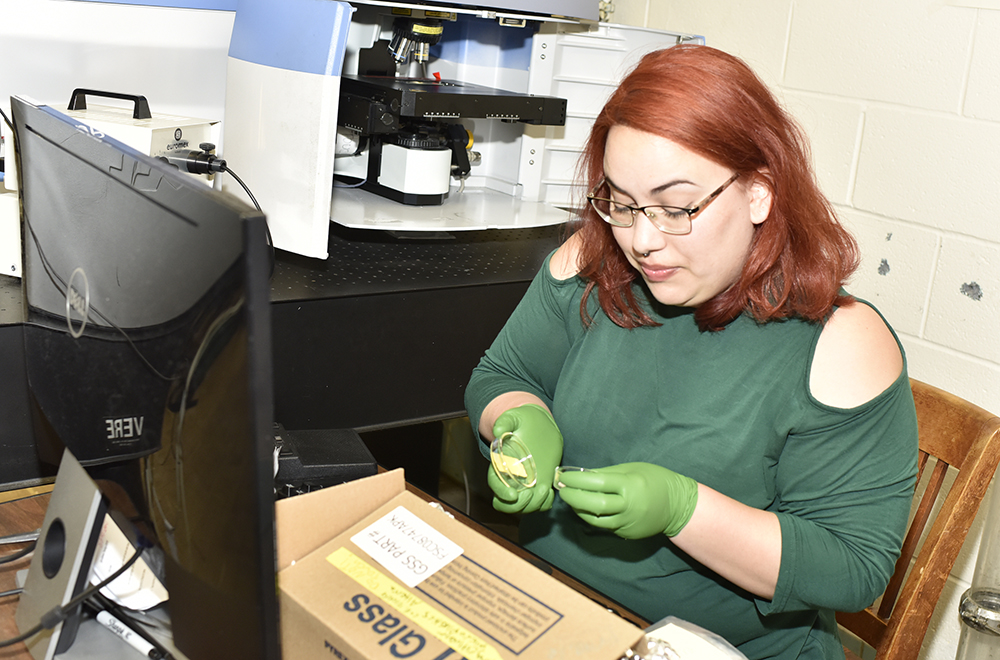Tiny plastics, big environmental risk: UMD researcher sheds new light on sorption
Microplastics—tiny fragments of plastic—regularly end up in our drains. They can include small bits of plastic shed from a scrubbing brush while we’re washing the dishes, fibers from polyester clothes, or the microbeads found in toothpaste, cleansers, and exfoliants. Chemicals spill into our drains as well, often as a result of using pharmaceutical and personal care products (PPCP). When microplastics and chemicals mix, they become multiple stressors to the environment: that is, they pose a greater risk to organisms together than they would alone. The microplastics act as carriers for pollutants, transporting them much farther than they could go on their own, explains Alterra Sanchez, a civil and environmental engineering doctoral candidate conducting research through the Marine Estuarine and Environmental Sciences program. “These tiny plastic fragments—and the pollutants they carry--are ending up in our rivers and oceans, and can end up in the seafood we eat,” she explains. Working with Dr. Alba Torrents and co-advisor Dr. Lance Yonkos, Alterra has been conducting research that sheds new light on the interaction between microplastics and PPCP chemicals—and suggests gaps in the way it is currently being studied. At the core of her investigation is a process that resembles dirt or oil trapped in a sponge. When organic pollutants come in contact with microplastics, they adhere and do not want to come off. Environmental scientists refer to this bonding as sorption, and it creates a hidden environmental hazard, Alterra notes. “The microplastics, carrying the pollutants, can travel from wastewater treatment plants into rivers, and then the ocean, where they may release these pollutants in pristine waters that previously have not been exposed to these chemicals. Fish and marine birds like to eat microplastics, especially red and orange pieces that look like shrimp, so they will be exposed to PPCPs.” she says. Scientists seeking to measure the extent of this problem have investigated how different microplastics interact with chemicals and how they may increase exposure to wildlife. However, Alterra says research up until now has not always considered all the important variables involved. “The amount of sorption is influenced not only by plastic type, but also size and surface area,” she says. Alterra reached this conclusion by closely studying the interaction between triclocarban—an antibacterial chemical widely used in soaps and lotions—and simulated weathered microplastics of the kind that can end up in the water supply. Harvesting microplastics isn’t easy to do, so she used a different approach: she created her own collection. “The particles I made are pitted and deformed, like the plastic pieces you would find in the environment,” she says. Because she studied a variety of plastic types, sizes, and surface areas, she was able to show that, when it comes to sorption, particles vary sometimes in unexpected ways. Testing two types of plastic—polypropylene (PP), which is used in plastic food wraps; and high-density polyethylene (HDPE), used to make most reusable water bottles—she found triclocarban stuck to PP much more. “It turned out that PP is a much better sorbent for this chemical, compared to HDPE,” Alterra said. “PP also has a greater surface area. That means not only a greater tendency for sorption, but that there is much more space for the sorption to occur. As a result, PP could present more of a hazard in terms of toxicity for chemicals like triclocarban.” The finding is a surprise, Alterra says. “It challenges the current understanding that polyethylene is usually a better sorbent for organic pollutants. The discovery was possible because I used different sizes and typesof microplastics, each with a different surface area,” she says. “In the future, scientists will need to consider particle size and surface area, not just plastic type, when testing microplastic toxicity.” Alterra Sanchez prefers to be addressed by her first name; no mistake has been made by the author.
Related Articles: June 14, 2019 Prev Next |


